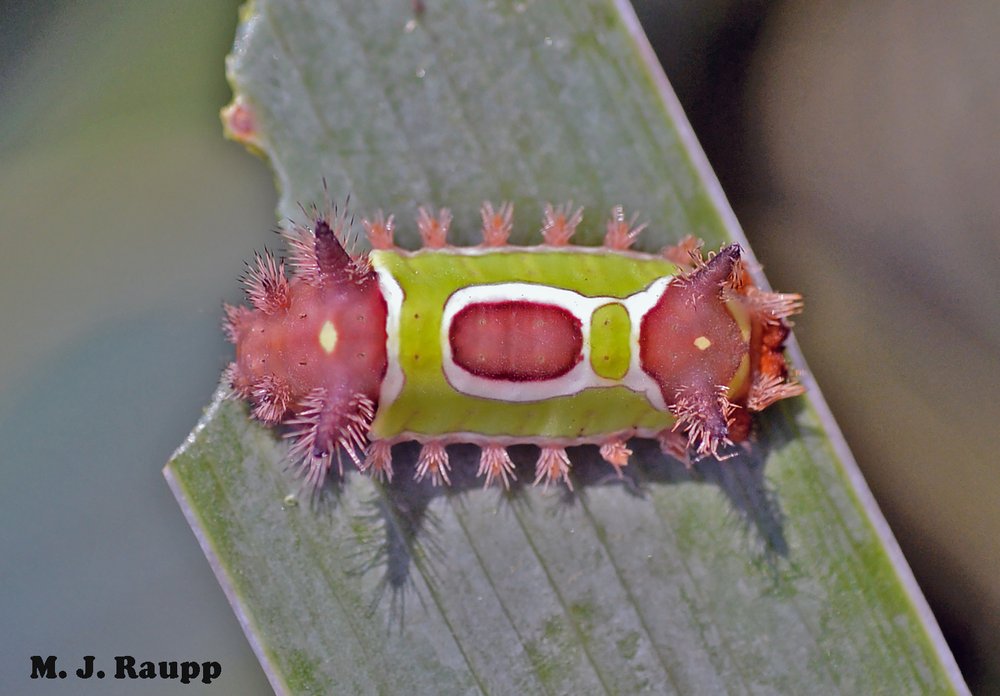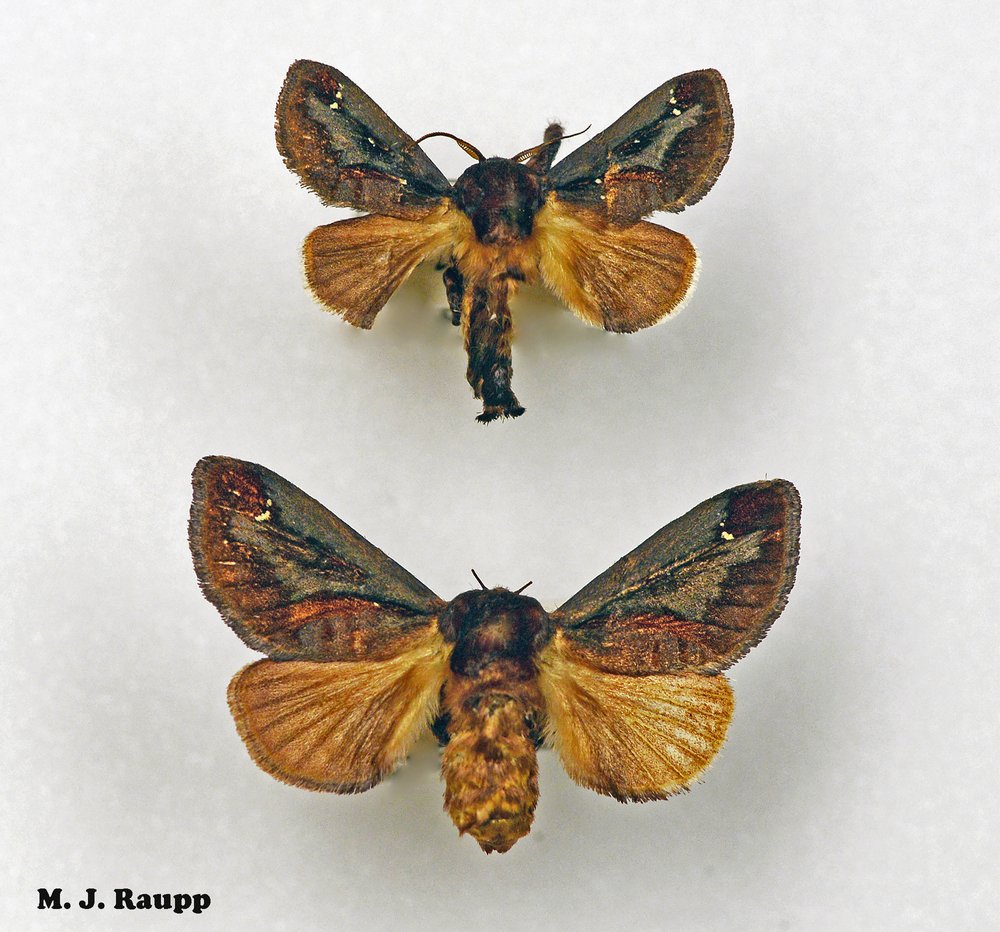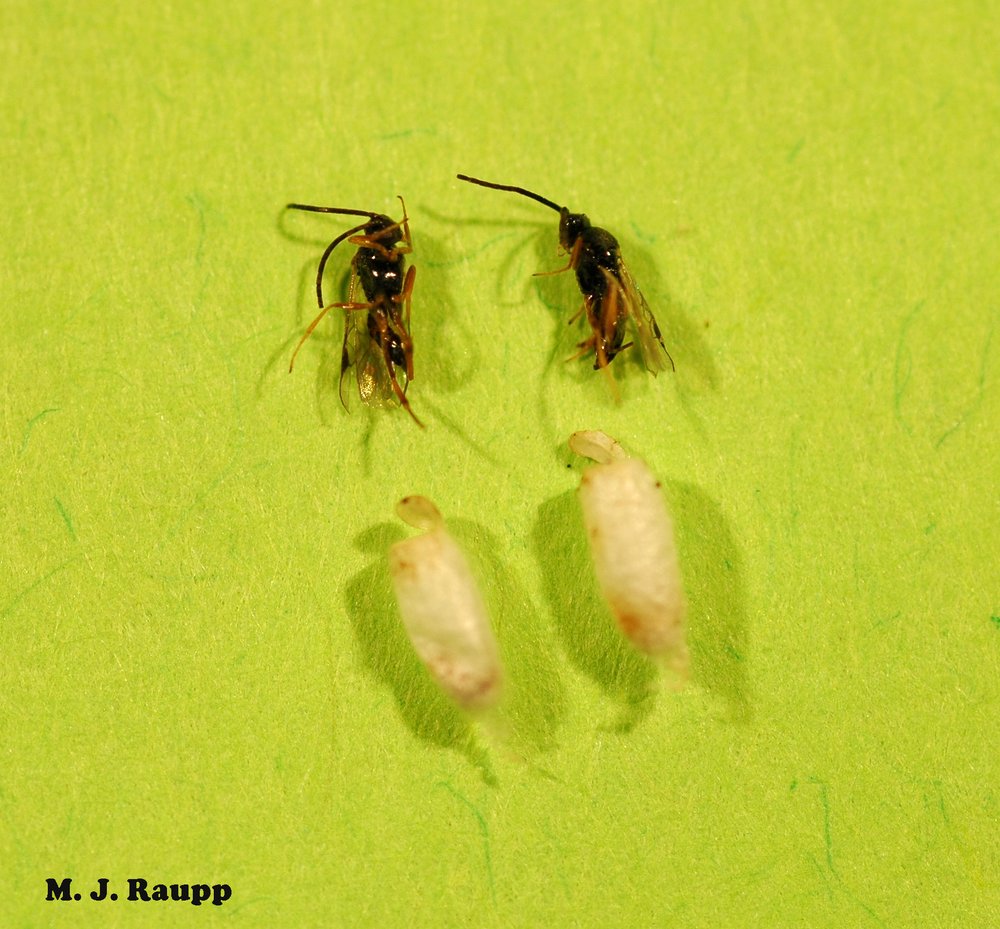
Front, rear, and along the flanks, venom glands in the skin of the caterpillar prepare a potent venom delivered via urticating hairs.
Last week ago, while mowing the lawn, I felt a familiar stinging sensation on my left calf after brushing up against some plants at the border of a flower bed. This surely felt like the burning pain associated with the sting of a caterpillar, but a cursory inspection of the vegetation failed to reveal a suspect. Fast forward to this week when, while pulling weeds in the same flower bed, I was treated to several stings on my lower and upper arm. This time the culprit was easy to spot resting on an iris frond where I had apparently interrupted its lunch. One’s first encounter with the saddleback caterpillar is usually memorable, more likely to be experienced through the sense of touch rather than the sense of sight.
While weeding a flower bed, a saddleback caterpillar taught me a memorable lesson: don’t mess with a caterpillar armed with venomous spines. Watch as the saddleback defends its flanks from attack by a dissecting probe. First it turns left and engages the probe with large spines located on fleshy protuberances called scoli, found near the head and the tail. A gentle poke on the right side produces a similar defense. BTW, following this harassment, the saddleback shuffled down the leaf and resumed its meal unharmed.

Adult saddleback moths are rather nondescript rascals commonly seen in summer and autumn in the DMV (male above, female below).
Protecting the front and rear flanks of the garishly beautiful caterpillar are projections festooned with nasty spines. Like the stinging spines borne by the larvae of Io moths we met in a previous episode, these spines, or urticating hairs in entomological lingo, contain venom released upon contact with a would-be predator or unlucky human. According to Dr. Isadora Maria Villas-Boas and colleagues, the composition of the saddleback’s irritating venoms is not fully known. However, their symptoms include mild to severe burning sensations reminiscent of a wasp’s sting. In some cases, a very uncomfortable and persistent rash may develop at the point of contact. Reactions of some folks can be more troublesome with burning sensations lasting for hours or days rather than for minutes, with accompanying headaches, difficulty breathing, gastrointestinal discomfort, and in severe cases anaphylaxis.

Tiny brachonid wasps emerge from silken cocoons that festooned the exterior of a parasitized saddleback caterpillar.
One look at the saddleback caterpillar plainly explains its name. In the center of its back is a striking brown shield surround by a ring of white that closely resembles a saddle. Saddleback caterpillars eat a wide variety of plants in the forest and garden including oaks, elms, lindens, apples, plums, corn, blueberries, grapes, and apparently leaves of iris plants. With such a potent defense, one might think the saddleback has gained immunity from attack by enemies. Unfortunately for the saddleback, this is not the case. While hiking the Appalachian Trail a few years ago, I happened upon a most unfortunate saddleback caterpillar reliving a scene from the 1979 movie Alien, when the larval alien pops out of John Hurt’s chest. Festooning the back of the motionless caterpillar were dozens of tiny legless larvae. Spawned from eggs deposited in the saddleback caterpillar from a tiny wasp earlier this year, fully developed wasp larvae drilled their way through the skin of their victim and writhed on its back as they spun cocoons made of white silk. Observant gardeners have likely seen small white objects like these on the back of hornworms on tomatoes and identified them as eggs of some mysterious enemy of the caterpillar. In reality, these are cocoons of small parasitic wasps in the genus Cotesia.
In a scene straight out of Aliens, wasp larvae emerge from their saddleback host and spin white cocoons in which to pupate.
Female Cotesia wasps hunt saddlebacks and other caterpillars on the foliage of plants. Upon encountering a suitable host, they jump aboard and rapidly deliver many stings using an appendage called the ovipositor. Once inside the caterpillar, eggs hatch and wasp larvae feed on the tissues of its host. However, to survive successfully, the tiny wasp larvae must avoid death by the caterpillar’s vigilant immune system. This is where a little help from mother comes along. In addition to depositing eggs, mother Cotesia injects a special virus known as a polydnavirus into the caterpillar. The polydnavirus disables the caterpillar’s immune system, paving the way for her young to develop without interference. Once development is complete, wasp larvae move to the surface of the caterpillar, burrow through its skin, and spin a cocoon on the exterior of their host. Stinging and being stung, part of the circle of life in a bug’s world.
Watch this half-speed video as a parasitic wasp “stings” the saddleback and deposits her eggs.
Acknowledgements
We thank Ellery Krause and Dan Gruner for bearing the stings of caterpillars and capturing the wasps that inspired this week’s episode of Bug of the Week. The wonderful textbook “Medical and Veterinary Entomology” by Gary Mullen and Lance Durden, and fascinating articles including “Effects of the polydnavirus of Cotesia congregata on the immune system and development of non-habitual hosts of the parasitoid” by N. Lovallo, B. A. McPheron, and D. L. Cox-Foster and “Venomous caterpillars: From inoculation apparatus to venom composition and envenomation” by Isadora Maria Villas-Boas, Giuliano Bonfá, Denise V. Tambourgi were consulted to prepare this episode.
No comments:
Post a Comment